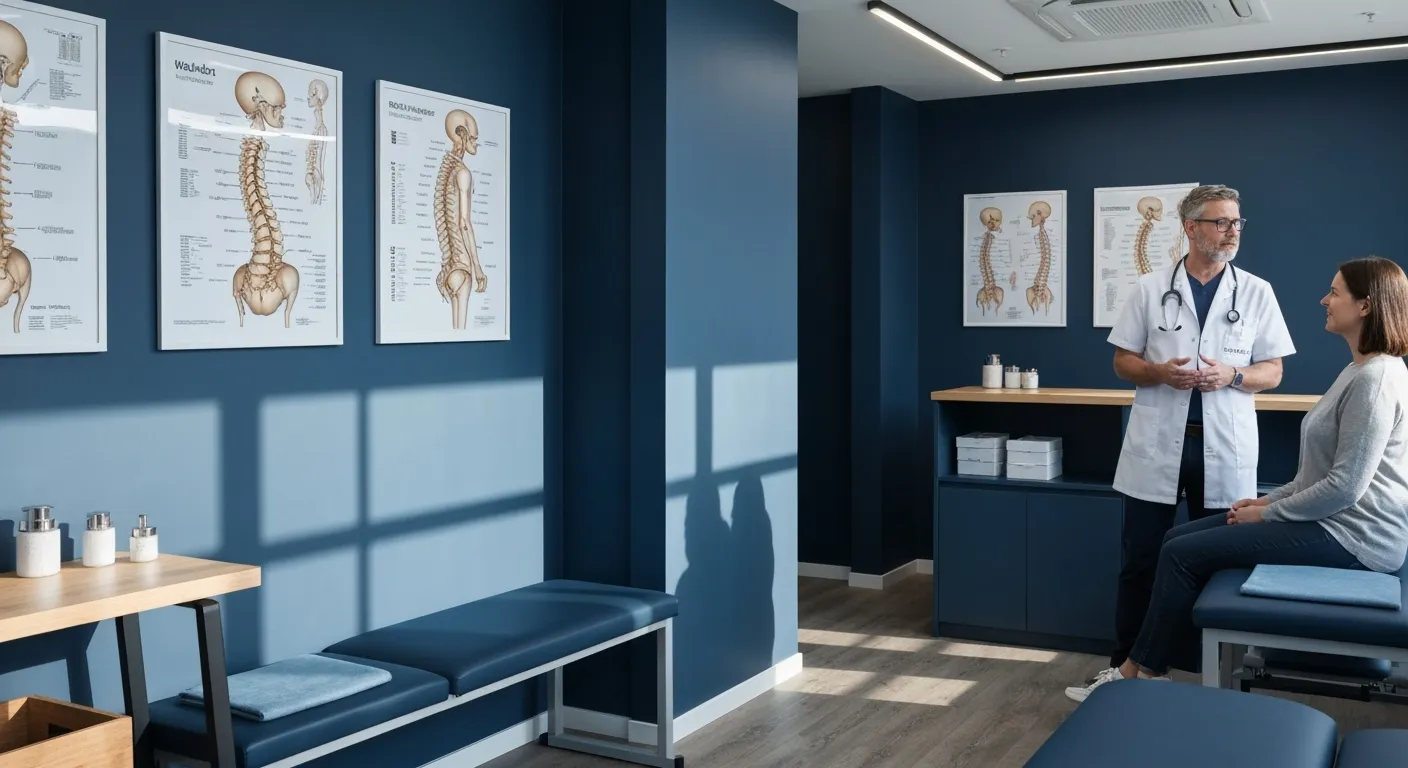Chiropractic Care: A Proven Solution for Alleviating Back Pain
October 12, 2025
12 min

The Growing Need for Effective Back Pain Solutions
Back pain remains a leading cause of disability worldwide, affecting millions and imposing substantial economic and personal burdens. With conventional treatments often involving medications, injections, or surgery, many seek alternative and complementary approaches. Chiropractic care has emerged as a proven, non-invasive treatment method that offers relief and improved function for various back conditions. This article explores the scientific evidence supporting chiropractic care, detailing how it works, its benefits, safety considerations, and its role within holistic health and cost-effective healthcare strategies.
Understanding Back Pain: Causes, Symptoms, and Management Strategies

What are common causes, symptoms, and management strategies for back pain?
Back pain is one of the most common health issues worldwide, affecting over 11% of the global population. Its causes are diverse, typically falling into two broad categories: mechanical and internal. Mechanical causes include muscle strains, ligament sprains, herniated discs, arthritis, degenerative disc disease, spinal stenosis, osteoporosis, and structural issues like scoliosis. These often result from injury, poor posture, or repetitive movements. For a detailed overview of what causes back pain, see this source.
Referred pain from internal organs is also a notable contributor to back discomfort. Conditions such as kidney stones, infections, abdominal tumors, or gynecological problems can mimic spinal pain, sometimes accompanied by systemic symptoms like fever or weakness.
Symptoms of back pain vary widely. Localized discomfort might feel like aching, stiffness, or shooting pain. Some experience muscle spasms or limited movement. In cases involving nerve compression, symptoms can include numbness, tingling, weakness, or radiating pain down the legs, known as sciatica. Severe cases may lead to neurological deficits or systemic signs signaling serious underlying issues.
Managing back pain primarily involves conservative, non-surgical approaches. Physical therapy plays a central role, emphasizing exercises to strengthen supporting muscles, improve flexibility, and correct posture. Medications such as non-steroidal anti-inflammatory drugs (NSAIDs) provide pain relief. Ergonomic adjustments—like proper workstation setup—and patient education on activity modification are crucial. Lifestyle changes, including weight management and quitting smoking, help prevent future episodes. Many of these non-surgical treatments for back pain can be effective in reducing pain and preventing recurrence.
In more severe or persistent cases, where conservative measures fail, surgical options may be considered, especially if there are significant neurological impairments or structural abnormalities. Preventive strategies focus on maintaining a healthy weight, staying active, practicing correct lifting techniques, and avoiding prolonged inactivity or bed rest after initial injury. For additional home-based strategies, see back pain home remedies. Overall, early intervention with appropriate therapy, lifestyle modifications, and awareness of warning signs can significantly improve outcomes and reduce long-term disability from back pain.
How Chiropractic Care Alleviates Back Pain: Mechanisms and Procedures

How do chiropractic adjustments and spinal manipulative therapy work to relieve back pain?
Chiropractic adjustments and spinal manipulative therapy (SMT) primarily function by applying controlled, targeted forces to specific joints within the spine. This manipulation aims to restore normal joint mobility, reduce nerve irritation, and alleviate pain. On a neurological level, these treatments can influence nerve pathways at both the segmental (spinal cord level) and central nervous system levels, helping to dampen pain hypersensitivity and reduce central sensitization—where the nervous system becomes overly responsive to stimuli. Evidence shows that SMT produces immediate hypoalgesic effects, such as decreasing pain amplification associated with central sensitization mechanisms. Additionally, SMT can modulate neuroinflammatory responses in the body, involving cytokines like TNF-α, which are linked to pain and inflammation. Besides easing nerve pressure, these therapies improve muscle movement and correct biomechanical misalignments, supporting the body's natural healing processes and leading to significant pain relief. Although the exact mechanisms continue to be explored, current research indicates that both peripheral and central nervous system pathways are influenced, resulting in lowered pain perception and enhanced function.
What are the procedures, purposes, and safety considerations of chiropractic interventions for back pain?
Chiropractic care involves a comprehensive assessment that includes reviewing the patient's medical history, physical examination, and often diagnostic imaging such as X-rays when necessary. Licensed chiropractors perform manual adjustments or mobilizations—precisely controlled force applications to spinal joints and related structures—to address musculoskeletal issues. The main goals are to reduce pain, improve joint mobility, restore proper spinal function, and relieve associated symptoms like headaches or muscle tension. During a typical treatment, patients lie on a specialized table while the chiropractor uses hands or small instruments to apply force, often producing a popping or cracking sound caused by the release of gas in the joint spaces.
Safety considerations are vital: practitioners screen for contraindications such as fractures, severe osteoporosis, infections, or spinal instability. When performed by trained, licensed professionals, chiropractic care is generally very safe, with serious adverse effects being exceedingly rare. Mild, temporary side effects like soreness, fatigue, or headaches may occur but usually resolve within a day or two. Overall, chiropractic interventions are effective and safe options for many back pain conditions, provided they are tailored to the individual patient's health status and performed with appropriate expertise. For more details on the chiropractic adjustment procedure, benefits, and risks and safety considerations, see these resources.
Scientific Validation and Clinical Evidence Supporting Chiropractic Care

Research studies and randomized controlled trials
A significant body of scientific research supports the effectiveness of chiropractic care, especially spinal manipulative therapy (SMT), in treating back pain. Large-scale studies, such as one involving 128,377 veterans, demonstrated that chiropractic care can substantially reduce the need for opioid prescriptions in patients with low back pain (source).
Randomized controlled trials have shown that chiropractic adjustments can produce modest but meaningful improvements in pain and physical function. For example, studies comparing SMT to minimal intervention or placebo suggest that spinal manipulation offers at least as much relief as other conservative treatments, including physical therapy or medication, particularly for non-specific and acute low back pain (source; source).
Clinical guidelines endorsing chiropractic spinal manipulation
Numerous health organizations worldwide recognize chiropractic SMT as a recommended treatment option for back pain. The American College of Physicians and the UK's NICE guidelines both recommend SMT as part of a multimodal approach for acute, subacute, and chronic spine pain. These guidelines suggest that SMT can be effective when combined with exercise, patient education, and lifestyle modifications.
The American Pain Society supports the position that spinal manipulation is a reasonable first-line treatment for such conditions. An expert consensus from the RAND-UCLA methodology reinforces the endorsement of chiropractic care within clinical practice guidelines, emphasizing its comparable efficacy to other non-invasive therapies (source).
Evidence of efficacy and areas needing further research
While evidence-based reviews show that chiropractic care, especially SMT, improves pain and disability in many cases, the overall quality of research varies. The specific effects over placebo are still somewhat uncertain, mainly due to limitations in study designs and placebo controls (source).
Future research is needed to clarify which patient subgroups benefit most from chiropractic interventions and to better understand the mechanisms underlying SMT's effects. Ongoing studies aim to improve placebo control designs and identify predictors of treatment success (source).
In summary, current scientific evidence and clinical guidelines firmly support chiropractic care as an effective, safe, and cost-efficient option for managing back pain. Its integration into multidisciplinary treatment plans enhances patient outcomes and satisfaction (source; source).
Health Benefits and Potential Improvements from Chiropractic Treatment

What are the benefits and potential health improvements associated with chiropractic treatment for back pain?
Chiropractic care provides numerous health advantages, particularly for individuals suffering from back pain. One of the primary benefits is effective pain relief. Studies have shown that chiropractic spinal manipulation, a core technique, can significantly reduce pain levels, sometimes matching or surpassing the effectiveness of medication, and often with fewer side effects.
Beyond pain management, chiropractic treatment can enhance spinal function and increase flexibility by realigning joints and improving range of motion. These adjustments help alleviate muscle tension, reduce inflammation, and improve overall posture, which is vital for preventing future injuries.
Patients often experience immediate symptom reduction following adjustments, along with long-term benefits like better mobility and decreased disability. Effective treatments can also help address related conditions such as headaches, muscle spasms, and nerve irritation. Incorporating prescribed exercises and ergonomic advice, chiropractic care promotes better body mechanics and posture, contributing to sustained health improvements.
When performed by licensed professionals, chiropractic interventions are generally safe, with serious complications being very rare. The holistic approach not only alleviates pain but also supports functional gains and quality of life improvements, making it a valuable addition to comprehensive back pain management strategies.
Comparative Effectiveness and Cost-efficiency of Chiropractic Care
How does chiropractic care compare to other treatment methods in terms of cost-effectiveness and outcomes for back pain?
Chiropractic care, especially spinal manipulation, has been shown to be a broadly effective and economical option for managing back pain. It often serves as a first-line treatment, which is supported by research indicating that initiating care with a chiropractor can substantially lower healthcare costs—typically by around 20-40%. These savings are due to decreased reliance on medications, imaging, injections, and even surgeries.
Compared to other conventional treatments such as physical therapy and standard medical care, chiropractic interventions usually yield similar or slightly better patient outcomes. Studies have reported high patient satisfaction, with many patients experiencing significant reductions in pain and improvements in mobility following chiropractic adjustments. Notably, patients receiving chiropractic care tend to use fewer opioids, contributing to lower overall treatment costs and reduced risks associated with long-term opioid use.
A comprehensive analysis of healthcare claims from multiple states revealed that adding chiropractic services to usual medical care for back pain was associated with moderate clinical benefits and considerable cost reductions. Over a period of six months, patients under chiropractic care were on average 36% less expensive for treatment than those who received standard medical care alone (source).
While some limitations in existing research, such as study design and sample diversity, suggest the need for further high-quality investigations, the current evidence strongly supports chiropractic care not only as an effective option but also as a cost-saving strategy for spine-related conditions. Broadly, policy initiatives promoting early access to chiropractic services could significantly reduce the overall economic burden of back pain on the healthcare system (detailed review).
Chiropractic Care Within Holistic Health and Wellness Framework

Chiropractic care plays a significant role in a holistic approach to health by focusing on maintaining optimal spinal and nervous system health. Proper alignment of the spine is crucial because it supports nerve function and overall body harmony, which are essential for natural healing and disease prevention (Chiropractic care for back pain).
In addition to therapeutic adjustments, chiropractors often provide guidance on lifestyle habits that promote health, such as regular exercise, balanced nutrition, stress reduction techniques, and ergonomic practices. These self-care strategies help individuals maintain spinal health, reduce the risk of injury, and manage chronic conditions proactively (Postural and exercise education, Ergonomic training in chiropractic, Stress management techniques for back pain).
Prevention is a core aspect of holistic chiropractic practice. By addressing biomechanical disturbances early and educating patients about proper posture and movement, chiropractors empower individuals to take charge of their health. Recommendations may include stretching routines, dietary adjustments, and relaxation methods like mindfulness or yoga. These practices strengthen the body's resilience and support mental well-being (Lifestyle modifications for back pain, Stretching and posture retraining).
Integrating chiropractic care with healthy lifestyle choices fosters long-term wellness. Regular visits, combined with personal efforts in nutrition, activity, and stress management, help improve sleep quality, boost immune function, and reduce the reliance on medications. Overall, chiropractic care serves as a vital component in a comprehensive wellness routine, emphasizing prevention, self-care, and the body's innate capacity to heal itself (Chiropractic care benefits, Pain management with chiropractic, Non-invasive back pain relief).
Patient Safety, Risks, and Appropriate Use of Chiropractic Care
In what conditions and scenarios is chiropractic care most beneficial for back pain relief?
Chiropractic care is particularly effective for individuals with nonspecific acute or chronic low back pain, especially when the pain stems from mechanical issues like joint or muscle dysfunction. It is also beneficial for sacroiliac joint problems and certain cases of neck pain, headaches, and sciatica, provided there are no underlying contraindications. Most patients experience relief after a few sessions, typically spanning several weeks. The treatment involves spinal manipulation and manual therapies aimed at realigning joints and reducing muscle tension. These interventions help improve mobility, decrease pain, and support body's natural healing abilities.
However, the safety of chiropractic treatment hinges on appropriate assessment. Licensed chiropractors perform thorough evaluations, including medical history, physical exams, and imaging when necessary, to screen for serious conditions (chiropractic patient assessment).
Screening and contraindications
Proper screening is essential before chiropractic adjustments. Patients with severe osteoporosis, spinal instability, infections such as discitis or osteomyelitis, or neurological deficits should avoid or modify treatment to minimize risks. Conditions like fractures, systemic inflammatory diseases, or tumors also contraindicate chiropractic manipulations. Screening helps ensure that adjustments are safe and appropriate, reducing the likelihood of adverse events (risks of chiropractic treatment).
Frequency and typical course of treatment
Most cases see significant improvement within a short course of care. Initial visits are often scheduled two to three times a week, with the number of sessions decreased as symptoms improve. Chiropractic care for back pain generally involves 4 to 6 sessions over 2 to 3 weeks, but the exact number varies based on individual response and the severity of the condition. Long-term management may include advice on posture, lifestyle, and exercises to prevent future issues. Establishing a tailored plan with regular evaluations helps maximize benefits and safety (dose-response for chiropractic care; postural and exercise education).
Rare but possible complications and ways to minimize risk
Although serious complications are rare, they can include herniated disks, nerve compression, or very rarely, strokes following neck adjustments. To minimize these risks, only licensed and trained chiropractors should perform adjustments. They use specific screening protocols to identify patients at risk. Additionally, employing gentle techniques and avoiding high-velocity thrusts in vulnerable individuals reduces the chance of adverse effects. Patients should report any unusual symptoms immediately after treatment, such as severe pain, dizziness, weakness, or numbness (chiropractic risks and complications; risk of stroke and chiropractic treatment).
In summary, chiropractic care, when administered by qualified professionals with proper screening, is a safe and effective option for many experiencing back and neck pain, especially for those with mechanically induced, nonspecific pain conditions (clinical effectiveness of chiropractic spinal manipulation).
Integration of Chiropractic Care in Multidisciplinary Back Pain Management
Chiropractic care has gained recognition as a legitimate and validated approach to managing back pain within a multidisciplinary healthcare framework. Its scientific foundation is supported by extensive research, including randomized controlled trials (RCTs), systematic reviews, and established clinical guidelines. These studies generally endorse spinal manipulative therapy (SMT) as an effective conservative treatment for non-specific, acute, and chronic spine conditions, demonstrating benefits in pain relief, functional improvement, and patient satisfaction.
Research data show that chiropractic care, particularly SMT, can reduce reliance on opioids, lower overall healthcare costs, and improve health outcomes. For example, large-scale studies involving veterans and military personnel reveal significant reductions in medication use and shorter episodes of pain when chiropractic interventions are integrated with standard medical care (effect of chiropractic care on low back pain). Clinical guidelines from organizations such as the American College of Physicians recommend spinal manipulation as part of a multimodal treatment approach with exercises and education.
Moreover, the growing incorporation of evidence-based practices into chiropractic education and the profession's rigorous standards bolster its clinical legitimacy (Evidence-Based Practice in Chiropractic Care). Risks associated with chiropractic treatments are minimal and primarily involve mild, transient side effects, making it a safe adjunct or alternative to invasive procedures (Safety of chiropractic adjustments).
Integration with other disciplines—such as physical therapy, medical practitioners, and mental health professionals—is crucial for comprehensive spine care. Coordination within this team allows for personalized treatment plans that address both biomechanical and psychosocial factors in back pain (Chiropractors and medical professionals collaboration). This multidisciplinary model promotes a holistic approach, optimizing patient outcomes.
In summary, evidence emerging from scientific literature, clinical guidelines, and real-world applications establish chiropractic care as a validated, effective, and safe component of comprehensive back pain management in contemporary healthcare settings (Chiropractic care for back pain, Clinical effectiveness of chiropractic spinal manipulation).
Chiropractic Care: A Trusted Ally Against Back Pain
Chiropractic care represents a scientifically supported, effective, and safe option for managing back pain, offering non-invasive relief and functional improvement. Through spinal manipulation and complementary therapies, chiropractors address the underlying biomechanical causes of pain, enhance mobility, and reduce reliance on medications with potential side effects. Research and clinical guidelines endorse chiropractic interventions as an integral part of comprehensive back pain treatment, often yielding cost savings while improving patient satisfaction. When combined with healthy lifestyle habits and coordinated healthcare, chiropractic care promotes holistic wellness, prevention, and long-term quality of life. As evidence grows and further research clarifies optimal patient selection, chiropractic care stands as a proven solution transforming back pain management worldwide.
Recent articles

Effective Corrective Exercises for Long-Term Pain Relief

Back Pain Benefits: What Chiropractic Care Can Do for You

Spinal Decompression Techniques for Effective Sciatica Relief

Top Nutritional Counseling Tips for Enhanced Wellness

6 Lifestyle Habits That Boost Spine Health Daily

Discover Holistic and Non-Surgical Pain Relief Solutions

Exploring Holistic and Non-Surgical Treatment Options for Pain

The Role of Physiotherapy in Enhancing Chiropractic Care Outcomes

Complementing Chiropractic Care with Physiotherapy: What You Need to Know

What to Expect During Your First Chiropractic Visit

Simple Lifestyle Adjustments to Maintain a Healthy Spine

Personalized Nutritional Counseling for Improved Health Outcomes

Exploring Non-Surgical Treatments for Spine-Related Conditions

An Introduction to Spinal Decompression for Sciatica Patients

Transformative Success Stories: Patient Experiences with Chiropractic Treatments

Why Chiropractic Care Is Essential for Back Pain Relief

Addressing Underlying Causes Versus Symptom Management in Pain Care

The Role of Nutrition in Enhancing Chiropractic Treatment Effectiveness

Sciatica Treatment Options: Is Spinal Decompression Right for You?

Lifestyle Tips to Maintain a Healthy Spine and Prevent Back Issues

The Synergy Between Physiotherapy and Chiropractic Treatments

What Happens During Your Initial Chiropractic Consultation

Effective Corrective Exercises for Sustainable Pain Management

Taking a Root Cause Approach to Chronic Pain Management

Holistic Pain Management Techniques Without Surgery

How Patient Success Stories Validate Chiropractic Care Benefits

Spinal Decompression: Innovative Treatment for Sciatic Nerve Pain

Spinal Decompression Therapy: A Non-Invasive Approach to Sciatica Relief

Exploring Holistic Approaches Beyond Surgery for Pain Relief

Practical Lifestyle Advice to Support a Healthy Spine Every Day

Corrective Exercise Routines Designed for Long-Term Pain Prevention

Real Patient Stories: Overcoming Chronic Pain with Chiropractic Care

Lifestyle Changes That Promote a Healthy Spine and Prevent Injury

How Addressing the Root Cause of Pain Leads to Lasting Relief

Non-Surgical Holistic Therapies to Manage Chronic Pain Effectively

Nutritional Counseling's Impact on Physical Health and Healing

Benefits of Regular Chiropractic Care for a Stronger Back

Your First Chiropractic Visit: What to Expect and How to Prepare

Patient Experiences: How Chiropractic Care Transformed Their Lives

Exploring Holistic, Non-Surgical Options for Pain Management

Combining Physiotherapy with Chiropractic Treatments for Enhanced Recovery

Holistic Treatments That Offer Alternatives to Surgery for Pain Relief

Corrective Exercise Strategies for Long-Term Spine Health

How Physiotherapy Complements Chiropractic Adjustments for Better Outcomes

First-Time Chiropractic Visitors: What You Should Know

Understanding the Importance of Treating Pain at Its Source

Adopting Lifestyle Changes to Support Your Spine's Wellness

Utilizing Physiotherapy to Enhance Chiropractic Treatment Outcomes

The Key Advantages of Chiropractic Care for Back Pain Sufferers

Why Focusing on Root Causes Improves Pain Treatment Success

Corrective Exercises That Promote Lasting Pain Relief and Mobility

Sciatica Relief Through Targeted Spinal Decompression Techniques

Preparing for Your First Chiropractic Appointment with Confidence

Healthy Lifestyle Habits for Maintaining Spinal Alignment

Success Stories Highlighting Chiropractic's Role in Pain Recovery

Top Benefits of Chiropractic Care for Chronic Back Pain

Nutrition Tips to Boost Your Overall Wellness and Recovery

How Chiropractic Care Alleviates Back Pain Naturally

How Nutritional Counseling Supports Overall Wellness and Spine Health

Step-by-Step Guide to Your First Visit with a Chiropractor

Using Nutrition to Support Chiropractic and Overall Wellness

Integrating Physiotherapy in Your Chiropractic Healing Journey

How Physiotherapy Complements Chiropractic Adjustments for Faster Healing

Lifestyle Tips for Maintaining a Healthy Spine and Preventing Back Pain

Heartwarming Patient Testimonials Highlighting Chiropractic Success

How Proper Nutrition Supports Chiropractic and Physiotherapy Treatments

Combining Physiotherapy and Chiropractic Treatments for Optimal Recovery

Why Chiropractic Treatments Are Effective for Managing Back Pain

Choosing a Chiropractor: Tips for Finding a Trusted Provider

Integrating Physiotherapy and Chiropractic: Benefits and What to Expect

How Tailored Corrective Exercises Can Aid in Pain Management

Chiropractic Care: A Proven Solution for Alleviating Back Pain

What to Expect at Your First Chiropractic Visit: A Comprehensive Guide

The Importance of Root Cause Analysis in Effective Pain Management

The Role of Corrective Exercises in Sustaining Pain-Free Living

Combining Chiropractic and Physiotherapy for Comprehensive Pain Relief

How Addressing Underlying Causes Improves Pain Treatment Effectiveness

Maintaining Spinal Health Through Lifestyle Changes and Preventive Care

Understanding the Benefits of Chiropractic Adjustments for Back Pain Sufferers

Spinal Decompression Therapy: A New Hope for Sciatica Relief

Lifestyle Recommendations to Support a Healthy Spine and Reduce Pain

Choosing the Right Chiropractor: Key Factors to Consider Before Your First Appointment

Non-Invasive Treatment Alternatives: A Holistic Approach to Pain Relief

Corrective Exercises to Support Long-Term Relief from Chronic Pain

Exploring Non-Surgical Approaches to Spine Health and Wellness

Tips for Daily Habits That Keep Your Spine Strong

Success Stories: How Chiropractic Treatments Changed Lives

Why Focusing on the Root Cause of Pain Leads to Better Outcomes

Nutritional Counseling and Its Impact on Overall Wellness and Recovery

Patient Testimonials That Showcase the Power of Chiropractic Care

Preparing for Your First Chiropractic Appointment: What You Need to Know

Holistic Treatment Options: Beyond Surgery for Pain Relief

Holistic Pain Relief Methods That Avoid Surgery

Nutritional Strategies for Supporting Spine Health and Recovery

First Chiropractic Visit: What Happens and How to Prepare

Chiropractic Patient Success Stories: Inspiring Journeys to Wellness

Effectiveness of Spinal Decompression Therapy in Managing Sciatic Nerve Pain

Addressing Pain at Its Source: Why Treating the Root Cause Matters

Corrective Exercise Programs Designed for Long-Term Pain Prevention

